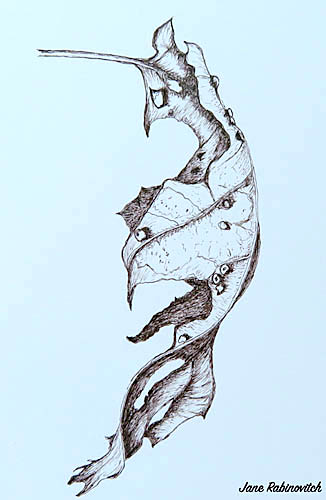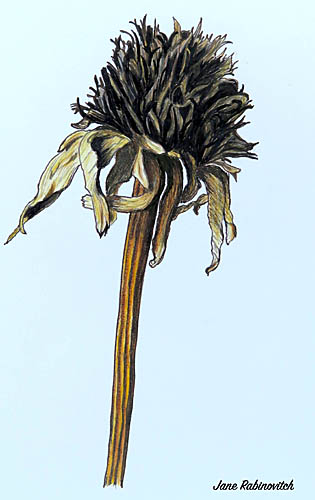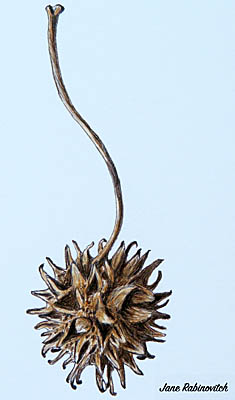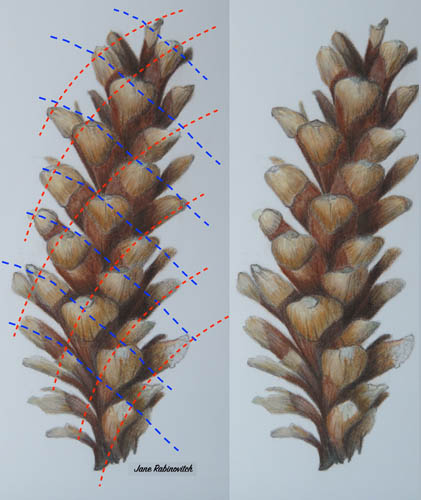The Sketcher’s Garden in Winter
By Jane Rabinovitch, Fairfax Master Gardener

Dried oak leaf
I love to garden and watch my plants grow and change over time. When I’m stressed, I find that walking through my garden and just sitting and observing can center me like nothing else. A few years ago, I wanted to try and take the beauty I was seeing in plants and capture it on paper. I started sketching in my garden and took some art classes to develop my skills. I have found that doing the drawings has given me a deeper appreciation for nature. I observe plants even closer now and I’m further fascinated by their form and function.
Winter may seem like a dull time to be out in the garden, but it can actually be a great opportunity for the beginner artist. With less leaves to get in the way, the structure of our plants and trees really shows through. There is also a shift currently in the gardening community to delay the fall garden clean-up. Authors like Douglas Tallamy are encouraging us to wait until spring to cut down our perennials and grasses so that birds can feast on seeds and insects can overwinter in hollow stems or on leaves. I endorse this mindset for all of these reasons, plus it gives me more time and things to sketch!

Echinacea flower head
Let’s start with leaves. It’s not just those beautiful fall colors, but even brown, curled up leaves are lovely. Some leaves have holes or galls or have been skeletonized by insects, but they each have a story to tell of what they experienced over the past year. I find this very grounding as I think back over my own year and the highlights and scars it may have left behind.

Liquidambar styraciflua seed
Dried flower heads can also be works of art. Coneflowers (Echinacea purpurea) are native to North America and have pinkish-purple flowers that bloom all summer long. The central cone is made up of hundreds of tiny flowers which bees and butterflies visit to sip nectar or gather pollen. The value of the flower heads continues into fall and winter with songbirds eating the seeds. I think the remaining cone with all of its spiky crevices and withered petals is also beautiful and fun to draw.
Seed pods are fascinating little structures. The sweet gum tree (Liquidambar styraciflua) is also native to North America and produces one of my favorite seed capsules. I know that some people dislike the tree for the mess and walking hazards of these seed “balls,” but I think they are amazing to study and attempt to sketch. Each of those holes on the balls contains two winged seeds that are eaten by small birds, chipmunks and squirrels. The spring flowers of this tree also provide nectar for hummingbirds, and the leaves are host to the luna and promethea moths.

Pinus strobus
Lastly, we have pinecones. When you first look to sketch them, it can be overwhelming. There appear to be numerous crevices and points going every which way. But, once you understand that they are made up of two spirals going in opposite directions, it actually gives guidelines for the drawing. Eastern white pine (Pinus strobus) is native to our area and has lovely pinecones that are a winter food source for many mammals and birds. I have duplicated my drawing and added dashed lines showing the spiral guidelines I followed. Generally, where the dashed lines meet will be the tip of a scale.
I hope this helps you better appreciate the beauty in your winter garden and maybe even convinced you to try a few sketches of your own. It can take me many hours to do a drawing with my engineer/analytical side striving to get all of the details. Fresh flowers tend to wilt and change while I’m drawing, but dried leaves and seeds are perfect specimens with which to take your time! Enjoy!
References
Nature’s Best Hope, Douglas W. Tallamy, 2019
Eastern Purple Coneflower Plant Guide, USDA NRCS National Plant Data Center
Liquidambar styraciflua, North Carolina State University Extension
Pinus strobus, North Carolina State University Extension
Nature Follows a Number Pattern Called Fibonacci, Lee Reich, 2013